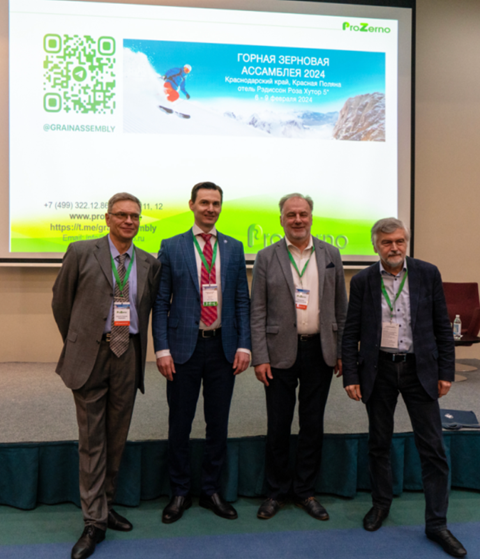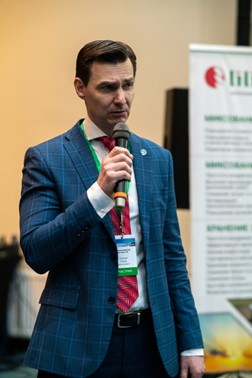FAO on top of the grain wave
-02-2024-png.jpg?sfvrsn=33d126aa_1)
©ProZerno analytical company
On 9 February, the Ninth Mountain Grain Assembly finished its work in the resort town of Rosa Khutor in Krasnodar Krai. The already traditional event happening halfway through the agricultural season is a professional discussion platform that brings together leading industry experts, analysts, heads of companies operating in the market of grain and products of its processing, and key agricultural producers from various regions of Russia.
The presentations and exchanges of views encompassed summing up interim results of the first half of the 2023/24 grain year, making weather forecasts for the coming months with an emphasis on the conditions for wintering of the winter cereals for the new harvest, discussing macroeconomic aspects of the Russian agricultural development, and outlining scenarios for the development of the grain and oilseed market this year.

Igor Shpakov, consultant at the FAO Liaison Office with the Russian Federation in Moscow, presented the data from The State of Food Security and Nutrition in the World 2023 flagship report. He said that while nowadays there is enough food produced to feed the world, around 780 million people globally still experience hunger or undernourishment.
"According to our forecasts, by 2030 the number of hungry people will have only decreased to 600 million. In addition, malnutrition has been on the rise recently, going to two obvious extremes. While people are starving in some countries, overnutrition is growing in others, and it is often associated with the consumption of cheap and low-quality food, “empty calories”. This is why today the number of hungry and obese people on the planet is approximately the same,” the expert said.

"FAO fully understands that in terms of improving global food security and eliminating hunger, the grain sector plays the main role. Thus, the Agricultural Market Information System (AMIS) has been operating within our Organization since 2008, providing a platform for carefully monitoring the situation regarding the main types of cereals and oilseed crops in the world. The major focus is on the four crops that, according to FAO experts, create food security: wheat, corn, rice, and soybeans,” the representative of the FAO Moscow Office noted.
Developing the subject, he shared the FAO forecasts for the next agricultural season with the participants of the session. “The total grain production in the world is expected to amount to 2.836 billion tonnes, which will be 1.2% (or 33 million tonnes) higher than the figures for last year. At the same time, the global coarse grains production is estimated at 1.523 billion tonnes, and this is where the growth dynamics is the highest, 3.6% more than the figure for the same period of 2022/2023.
The forecasted global grain stock is at a record-high of 895 million tonnes, which is 2.7% more than the level at the beginning of the season. The ratio of the global stock of grains to their consumption in the 2023/2024 season may amount to 31.1%. This is a pretty comfortable level, and it has remained virtually unchanged compared to last year,” Igor Shpakov noted.
"Overall, agricultural production in the world has been growing over the past decades, but it is now experiencing a significant slowdown. According to the OECD-FAO Agricultural Outlook 2023-2032, we estimate the global agricultural production growth to be no more than 1.1% per year over the next decade. This is due to new factors that ensure gross production and directly affect growth rates. For example, in the last century, the focus was on the extension of arable land and intensification of irrigation. As these resources were being depleted, economic entities began to heavily use fertilizers. As a result, a number of countries have reached a dangerous point fraught with soil depletion and degradation.
Today, most of developed agricultural countries are focused on increasing productivity through the introduction of new technologies, which requires significant investments in development and a solid scientific foundation,” the FAO consultant summed up his presentation.
According to the estimates of Vladimir Petrichenko, General Director of the ProZerno analytical company (organiser of the Mountain Grain Assembly), this season, the yield of wheat will amount to 92.7 million tonnes, which is somewhat less than in 2022, when Rosstat assessed the wheat yield at 104.2 million tonnes. The barley yield in weight after processing will amount to around 21 million tonnes (23.2 million tonnes in 2022). “The weather conditions facilitated the growth of corn yields to record levels, and the total yield may amount to 16–17 million tonnes (15.85 million tonnes in 2022). Grain processing shows an upward trend, too. The export of wheat flour has been growing in recent years, and the export result may exceed 1 million tonnes per season for the first time,” the expert emphasized.
Vladimir Petrichenko said that the preliminary results of the first half of the year demonstrate that a part of farmers involved in the production of oilseeds are still waiting for the maximum price for raw materials. Last season, it resulted in the record sunflower carryover in Russia. In part, this trend to curb sales has continued in the current agricultural year. At the same time, Russia has enough capacity to process the entire sunflower yield, provided that there are balanced loading and regular shipment of finished products.
“In the future, the growth in global demand for sunflower oil will contribute to an increase in export sales of the Russian oil and fat industry. At the same time, I urge market participants to take into account the whole range of factors influencing the global oilseed situation, and not expect a repetition of record prices,” Vladimir Petrichenko concluded.
Anna Budnikova, Director, Rostov branch of FSI Centre for Grain Quality Assurance, told assembly participants about the distribution of grain quality by region, the average gluten and protein contents in the newly harvested wheat, and the demand for Russian cereals in the global market.
“In 2023, our laboratories examined 15 agricultural crops from 67 regions of Russia with a total weight of over 64 million tonnes of grain, which amounted to 38.9% of the total yield in the regions. The preliminary results show that most of the examined soft wheat is food-grade: the share of the 4th grade remained at the level of last year (47%), and the share of the 3rd grade decreased slightly (to 24%). Rostov region with 15.4 million tonnes became the leader in grain harvest among Russian regions,” the expert noted during her presentation.
Deputy Director of the Federal Service for Hydrometeorology and Environmental Monitoring, Head of the Roshydromet Situation Centre Yuri Varakin said that in most Russian regions, this winter was characterized by heavy snowfalls, which significantly increased the height of the snow cover in the fields.
“In most of the territory of the European part of Russia, as well as the agricultural regions of the Ural Federal District and Western Siberia, agrometeorological conditions for wintering of the winter cereals will be mostly satisfactory. The high snow cover prevented soil from freezing, the freezing depth almost everywhere was small and ranged from 10 to 35 cm, and the minimum soil temperature at the depth of the tillering node of winter crops of 3 cm corresponded to the standard,” the representative of Roshydromet summarized.
“The global economy is slowing down against the background of continued high inflation and tightening monetary policy,” Andrey Klepach, Chief Economist at Vnesheconombank, said. According to the forecast of the VEB Institute for 2024, the global economic growth may amount to about 2.6%, while in a number of the world’s largest economies (the United States, Germany, and the United Kingdom) a short-term decline is possible during 2024. Moreover, debt and banking crises are still likely to occur in some countries and regions.
In Russia, trade balance in the mid-term will remain low but relatively stable. In the future, it will continue to decrease due to the faster growth of imports of goods and services compared to exports.
“India has opened the import of peas from Russia. This is what we have been waiting for the past seven years,” Sergey Pluzhnikov, Head of the analytical agency Russian Pulses Analytics, said. “The return of India is happening at a promising moment for Russia, since the pea harvest in our country is even higher than in Canada, which usually sets the benchmark for the production of this crop.”
The expert emphasized that, given the fact that “at the moment, Russia has already exported about 1.5 million tonnes of peas, and the production significantly exceeds domestic demand, we have a certain stock that we can safely offer to the market. A high yield will not become a problem for us, and markets for the sale of Russian products are open now,” Sergey Pluzhnikov summarized.
Heads and representatives of companies developing and producing agricultural equipment also addressed the forum. They proposed a number of solutions to improve the mechanization of harvesting, optimize current costs of storing grain and spoke in favour of a large-scale transition of Russian industrial agriculture economy to the high-level processing of obtained products.
FAO has a tradition of taking part in this expert and business forum. Presentations by the Organization’s experts always generate interest from participants, and Russian experts rely on FAO statistical data and forecasts in their work.
